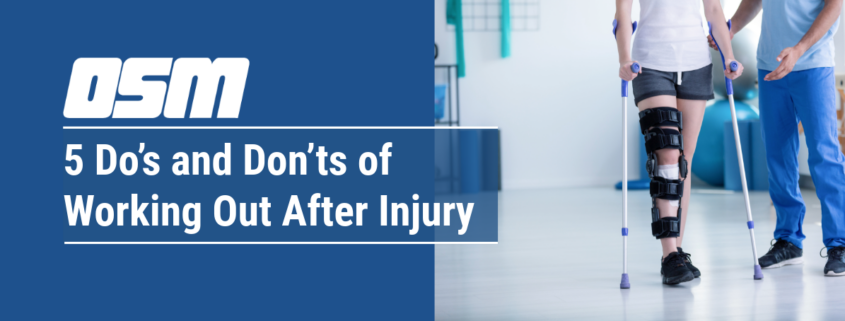5 Do’s and Don’ts of Working Out After Injury
Article featured on Hospital for Special Surgery
It can be tough to know how to safely return to exercise after you’ve been hurt.
Here’s how to get back to exercising after an injury.
1. Do check in with your doctor for a game plan.
First things first: If you have a persistent injury that you haven’t yet seen a doctor for, that’s step one. “The most important thing to do after an injury is to get the right diagnosis for treatment and a recovery plan,” Dr. Carr says. He explains that he customizes treatments and recovery programs based on his patients’ injuries and sports of choice. “Every injury is unique, and there are different demands on your body based on the activities you’re involved in. I won’t give the same advice to an equestrian that I would give to a soccer player, even for the same kind of knee injury.”
2. Don’t rush back too quickly.
If you were off for a week because of a shoulder injury, plan to take two weeks to get back to where you were before the injury,According to Dr. Carr, your recovery should last twice as long as the time that your injury kept you out of commission. “If you were off for a week because of a shoulder injury, plan to take two weeks to get back to where you were before the injury,” he says.
Keep in mind that the period in which you weren’t able to exercise or participate in sports affected more than just the injured area. “After a break, you lose strength, coordination and flexibility — not only where you were injured but also elsewhere in your body,” Dr. Carr says. That deconditioning, combined with adjusting your movements to compensate for weaker or painful areas, is how many people get hurt. “It’s common to come back from an injury and then get an injury in a different spot,” he says. “People with a hurt right knee will put more weight on their left side, for instance. That sets you up for another injury.”
3. Do start with small goals.
A journey of 1,000 miles starts with a single step — so do yourself a favor and make it a small one. “Go gradually, with the aim of slowly getting back to normal,” Dr. Carr says. Start with some easy stretching and strength training. “There are a variety of things you can do to regain flexibility and range of motion,” he adds, like Pilates or yoga. If you’re working out at home, try some flexibility training with dynamic (active) stretching.
As for strengthening, Dr. Carr advises starting with bodyweight or band exercises, cable machines or light weights. “Avoid Olympic weights and bench presses,” he says. “Increase your strength without loading your body too much. Then gradually work your way up to more weight.”
4. Don’t ignore pain.
Though we may enjoy the physical and mental challenges of being uncomfortable when we exercise, post-injury is not the time to push through pain. “Don’t be a hero,” Dr. Carr says. “Rehab is not the time to push it — don’t ignore pain, discomfort or other reactions in your body.”
Check in with your body before you exercise. “I tell patients that they need to have normal function for daily activities before they start exercising,” he says. “If you twinged your knee, and it hurts when you’re doing the dishes or walking up and down stairs, it’s going to hurt if you go for a four-mile run. Make sure you have no pain and full range of motion before loading the joint again. And if you’re feeling discomfort two days after exercise, or persisted through an activity despite pain, you’ve pushed too hard. Cut back on the effort.”
5. Do get back to what you love, once you’re ready.
Ultimately, you want to return to the exercises and activities you love — and you should! Once you’re pain-free, hit the courts or links for some limited play. “If you play tennis, for example, start with a few groundstrokes — but no serves,” Dr. Carr says. “See how you’re feeling during and after. The next time you go out, work the baseline a bit, maybe hit a couple serves. Work your way into it. Next time out, play a few points — a game or two. Then, by all means, test it out and play a match.”
Similarly, if your sport of choice is golf, start with chipping and putting. “Then play nine,” he says. “If that feels OK, go ahead and play 18 next time.”
“You want a nice, gradual return,” Dr. Carr says. “That’s how the pros do it. The skills will come back.”
The Orthopedic & Sports Medicine Center of Oregon is an award-winning, board-certified orthopedic group located in downtown Portland Oregon. We utilize both surgical and nonsurgical means to treat musculoskeletal trauma, spine diseases, foot and ankle conditions, sports injuries, degenerative diseases, infections, tumors and congenital disorders.
Our mission is to return our patients back to pain-free mobility and full strength as quickly and painlessly as possible using both surgical and non-surgical orthopedic procedures.
Our expert physicians provide leading-edge, comprehensive care in the diagnosis and treatment of orthopedic conditions, including total joint replacement and sports medicine. We apply the latest state-of-the-art techniques in order to return our patients to their active lifestyle.
If you’re looking for compassionate, expert orthopedic and podiatric surgeons in Portland Oregon, contact OSM today.
Phone:
Address
17355 Lower Boones Ferry Rd Suite 100A
Lake Oswego, OR 97035
Hours
Monday–Friday
8:00am – 4:30pm



